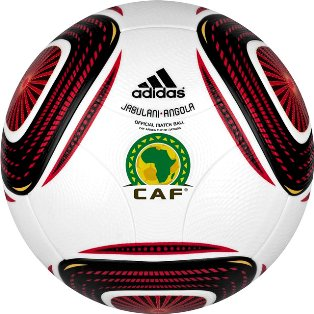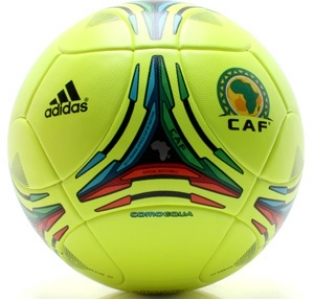Orange Africa Cup of Nations – Thursday 09 February 2012
 At the 2010 World Cup in South Africa, one of the talking points before and after the event was the Official match ball, the “Jabulani” (meaning, celebrate in Zulu). It came in for an enormous amount of criticism, with some claiming that the ball was too light and unpredictable in flight. Interestingly an earlier version of the ball had been used in January that year in the 2010 Africa Cup of Nations, where the Jabulani-Angola was the competition match ball. However, there was little criticism of the ball during that tournament. It may have been that issues were caused when the ball was modified for the World Cup. It may have been the altitude in South Africa. Or could the fact that once some starting complaining, a (possibly unfounded) seed of doubt was planted in players minds about the Jabulani?
At the 2010 World Cup in South Africa, one of the talking points before and after the event was the Official match ball, the “Jabulani” (meaning, celebrate in Zulu). It came in for an enormous amount of criticism, with some claiming that the ball was too light and unpredictable in flight. Interestingly an earlier version of the ball had been used in January that year in the 2010 Africa Cup of Nations, where the Jabulani-Angola was the competition match ball. However, there was little criticism of the ball during that tournament. It may have been that issues were caused when the ball was modified for the World Cup. It may have been the altitude in South Africa. Or could the fact that once some starting complaining, a (possibly unfounded) seed of doubt was planted in players minds about the Jabulani?

For the 2012 Orange Africa Cup of Nations, the “Comoequa” has been used. As with the choice of name for the tournament mascot (Gaguie), there is a simple reasoning to the match ball name. “Comoequa” originates from the River Como and the Equator, both of which pass through co-hosts, Gabon and Equatorial Guinea. It’s a colourful ball to say the least, as it is mainly yellow and features some of the colours from the flags of both co-hosts. In terms of performance, there doesn’t seem to have been any complaints from the players and from the games I have watched it doesn’t appear to have behaved in any peculiar way at all. What do they say about a poor workman?
 What you may ask has this to do with the Africa Cup of Nations? In watching the games and researching various aspects of the tournament, I came across the 2012 Orange Africa Cup of Nations mascot named Gaguie. Now you might think the name is from an old African dialect. In fact it is an amalgamation of the countries names who are co-hosting the tournament (Gabon and Equatorial Guinea). Simple, yet so effective. So what is Gaguie? Gaguie is a gorilla, but a gorilla with a message and was chosen as a symbol “…that represents the biodiversity and fauna of the central African ecosystems, spaces where both ecologic treasures suffer the danger of disappearance…” (from the Official Web Page of the Government of the Republic of Equatorial Guinea). Gaguie wears a football shirt which is blue, green and white (colours from the flags of Gabon and Equatorial Guinea). Again incredibly straightforward reasoning yet conveys the message of unity of the two co-hosting countries. Also, Gaguie is never seen without a football or in football action, so when looking at the mascot we know what sport it is representing. Some may say that it is all too simplistic. Really? I know which I prefer and which to me represents both the event, country and carries a serious message.
What you may ask has this to do with the Africa Cup of Nations? In watching the games and researching various aspects of the tournament, I came across the 2012 Orange Africa Cup of Nations mascot named Gaguie. Now you might think the name is from an old African dialect. In fact it is an amalgamation of the countries names who are co-hosting the tournament (Gabon and Equatorial Guinea). Simple, yet so effective. So what is Gaguie? Gaguie is a gorilla, but a gorilla with a message and was chosen as a symbol “…that represents the biodiversity and fauna of the central African ecosystems, spaces where both ecologic treasures suffer the danger of disappearance…” (from the Official Web Page of the Government of the Republic of Equatorial Guinea). Gaguie wears a football shirt which is blue, green and white (colours from the flags of Gabon and Equatorial Guinea). Again incredibly straightforward reasoning yet conveys the message of unity of the two co-hosting countries. Also, Gaguie is never seen without a football or in football action, so when looking at the mascot we know what sport it is representing. Some may say that it is all too simplistic. Really? I know which I prefer and which to me represents both the event, country and carries a serious message.